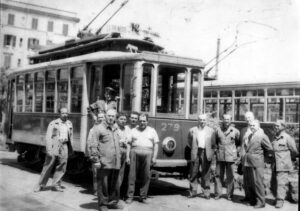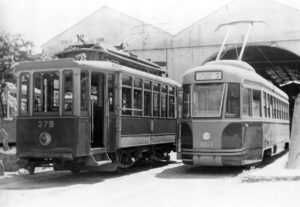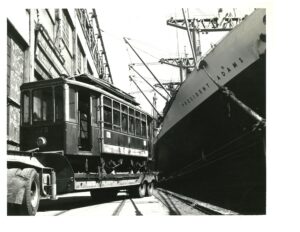
No. 279, believed to be when picked up by Seashore representatives in Rome; Dan Cohen collection.
Operating History: No. 279 is one of 91 single truck motorcars built for the government-owned Azienda Tranvie del Governor di Roma (ATAG) in 1911-1914. No. 279 is a composite steel and wood car and was designed to haul one or two trailers as was common in Europe at the time. During World War II, ATAG reduced the car’s seating capacity to just six seats to provide more space for standees. The seats were supposedly reserved for the elderly and infirm; everyone else had to stand. The car’s truck allowed some radial movement of the axles, and featured an unusual axle driven air compressor to operate the brakes. The tram had a bow trolley. Electrical equipment was constructed by the Continental General Electric Co., a subsidiary of the American parent company.
After 1930, ATAG began converting tram lines to bus operation. After World War II, ATAG changed its name to Azienda Tranvie ed Autobus del Comune di Roma (ATAC). ATAC continued bus conversions but never completely eliminated tram operation. Currently, ATAC operates about a half-dozen lines in Rome using principally modern, low-floor articulated trams of contemporary European design. Europe’s largest film studio, Cinecitta, was located on a tram line, and Rome’s trams often appeared in movies. Moreover, film makers sometimes drew subject ideas while watching fellow tram passengers.
Museum Ownership: The City of Rome, with the approval of the Mayor, agreed to donate No. 279 to Seashore in 1958. ATAC stored No. 279 in Rome until 1960 when the tram moved on a rail car to Leghorn and then by ship to Boston. Representatives of the city of Rome presented No. 279 to Seashore. No. 279 was Seashore’s first acquisition from continental Europe. It launched the museum’s Great World Capitals Collection. The diminutive car from the Eternal City has the smallest seating capacity of any car in Seashore’s collection. In 1964-65, the museum did a restoration job including a new roof canvas, exterior paint and interior refurnishing. The exterior work included applying the ancient seal of the city of Rome, bearing the initials SPQR (Senatus Populusque Romanum) [The Senate and People of Rome]. Seashore replaced the bow collector with a conventional pole for operation at the museum. No. 279 is believed to be the only Rome tram in the U.S. An organization in Rome has preserved another Rome tram.
Current Condition: No. 279 is in operating condition, but operation has been limited due to the car’s tiny wheel flanges and due to the fact that the Rome track gauge is 1445 mm rather than standard gauge of 1435 mm used at Seashore, both of which make it prone to derailments. The car’s low seating capacity makes it unsuitable for transporting museum visitors. No. 279 is currently on display for the general public inside Highwood Carhouse.

No. 279 in Rome, June 4, 1958; STM Collection.

No 279 arrives in Boston in 1960; STM collection.
 |
 |
 |
